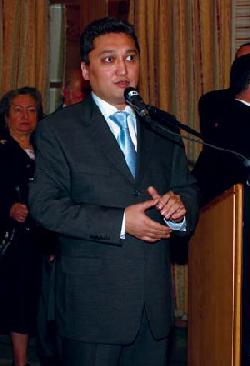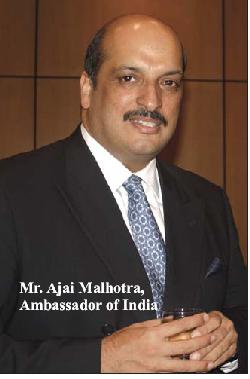 Kazakhstan - Oily tiger out to make friends Kazakhstan - Oily tiger out to make friends
A rapidly-growing eastern nation with a market for raw materials is hoping to boost its bilateral
trade with Romania
Twenty years ago a cabinet or coffee
table built in Bucharest was a prize much
sought after by the more privileged
members of the Kazakhstan region of the
Soviet Union.
“Our people knew how to notice good
quality craftsmanship and design and if
one family had Romanian furniture in
their apartment, it was a symbol of the
good life,” says Dr Eric Zhussupov, 33
year-old charges d'affaires and chief of
mission for Kazakhstan in Romania.
But, thirteen years on from the
separatist revolution of December 16
1991, most of the tables, chairs and
chests of drawers in the average
upmarket Kazakh flat are bought in from
Italy, Russia, the Ukraine or China.
Zhussupov argues this is a great
example of a good business opportunity
where Romanian firms can build upon
their previous good reputation for quality
standards. A furniture company could
therefore export its wares with the tagline
'Made in Romania' and knock it up at a
premium rate.
Physically, Romania is the closest
European Union candidate country to
Kazakhstan and while the eastern country has seen a massive growth in its
GDP of between nine and 11 per cent,
among the top of the ex-Soviet countries,
it has also benefited from Romania's need
for raw materials and its own ability to
provide them in enormously large
amounts.
Trade between the two countries is
increasing year on year, with the benefit firmly in favour of Kazakhstan. In 2003
exports from Romania to Kazakhstan
totalled 22.6 million USD and 240.9
million to Romania. While, for the first
nine months of last year, 337.2 million
USD in exports were made to
Kazakhstan and 18.3 million the other
way.
Kazakhstan's main exports to Romania
include oil, gas, cereal, coke and cotton,
as well as agricultural machinery There
is currently a pipeline from Kazakhstan
to Novorossisk, where the oil then travels
to Romania, mainly by tanker. In return,
Romania offers the ex-Soviet country
industrial machinery, electrical
equipment, furniture and textiles.
“There are a lot of opportunities not yet
realised,” said Zhussupov, whose job is
to stimulate more Kazakh business in
Romania. Next year he hopes for the first
Kazakh firm to open up a business in the
Balkan country, in either the banking or
oil sectors.
“The banking sector in Kazakhstan is
very well developed,” he says, citing five
years of privatization and a presence
already in the Russian Federation and
Ukraine, and with a hope to someday
reach Romania.
This would not be competition on the
retail circuit, but a specialist bank in the
energy and manufacturing sector for
business clients, which could begin with
a branch in Bucharest to support specific
companies in these categories
Further links between the two
countries could be improved. “Romania
has very good expertise in the industrial and machine-building sector, which is
very interesting for Kazakhstan,” says
Zhussupov. “Newly established in our
country is the state programme for
industrial and innovative development
that aims to put Kazakhstan on the
modern industrial map by 2015. In this,
the experience of Romanian engineers in
helping build new factories and industrial
machinery is very important.”
Many Romanian experts in oil, already
based in Kazakhstan in 1991, have stayed
there to build up the industry in a new,
free market environment, especially in
designing and building the pipeline
network.
There is also a large ethnic population
in Zhussupov's nation. He estimates
around 20,000 Romanians and
Moldovans live in Kazakhstan, which is
itself a melting pot of over 130
nationalities, many deported to the
district during the Communist period.
Liberalisation has allowed the former
capital Almaty to start offering a plethora
of different restaurants and even one
Balkan eatery called the 'Romanian
Courtyard' that serves up a selection of
mici, sarmale and marmaliga for those
homesick emigrés living at the cusp of
Asia.
However there is yet to open a Kazakh
Restaurant in Bucharest. “Once we have more firms established
here,” says Zhussupov, adding, as though
it were an incentive to boost business: “then we will need a kitchen.”
Michael Bird
 India diversifies trade options India diversifies trade options
We take a look at the trade between India and its Balkan partner,
following the Asian country's Republic Day on January 26
India is branching out from being a
trade partner in only steel and
metallurgy, with further investments in the tourism, textiles and film industries
and a promise of more FDI in the country. But tight tariff and Visa laws have
been seen by some as a handicap to a freer
form of trade.
“Both our economies are growing at a
healthy pace and there is tremendous
potential for future cooperation,” says
the Ambassador Mr.Ajai Malhotra.
The largest investment by Indian
individuals has so far been the Mittals'
LNM Holdings, who now own the Sidex
steel plant at Galati and smaller factories
in Iasi, Roman and Hunedoara. “Theirs is
one of the biggest foreign investments to
come t o Romania,” adds the
Ambassador.
In November 2001 the Government
sold 92 per cent of state firm Sidex to
LNM in a deal worth more than 500
million USD. LNM is now the largest
trading company in Romania, according
to the firm, accounting for three per cent
of GDP, four per cent of industrial output
and five per cent of its exports, with five
million tonnes of steel manufactured in
2004. The firm exports about 65 per cent
of its output.
“Commerce with India has a strong
history and has been going on for 40
years,” says Diwaker Singh, president of
the Indian BusinessAlliance of Romania,
which helps coordinate and promote Indian trade. “The purchase of Sidex was
an important factor which proved that
business could be profitable here.” He
says Indian firms could come to Romania
because there are still some opportunities
for Indian firms in privatisation,
Romania is a gateway to Europe with a
sea-port and is still a country with fairly
attractive labour costs. Now he is
receiving around five to six inquiries per
month from Indian firms interested in
expanding to Romania.
But there are problems. “There is a
draconian and archaic Visa system in
Romania which means it us far easier for
Indians to get into the EU and the USA,”
he says.
Indians also find it hard to sell their
products due to the high tariffs, which
demand payment of up to 30 per cent of
the costs at the border.
In IT and communications, Singh
sees great options. “India has become a
leading market for western nations to
outsource their call centres, but in terms
of European languages, it is mainly an
Indians are also promoting an ecotourism
with the establishment of the
luxury Delta Nature Resort in the Danube
Delta at Somova near Tulcea, which will
open this spring in a 6.5 million USD
investment, using Indian furnishings,
with an Indian chef and meditation and
nature therapy from Indian specialists,
plus 30 villas for upmarket nature
travellers.
Clothing is also showing growth. Last
year Tata International signed a Joint
Venture partnership with Romania
footwear producers Oxalaga to supply
finished leather products to central and
south-east Europe, with an ambition to
seize around ten per cent of the 400
millionUSDmarket.
“As a result of concerted efforts by
both sides, India-Romania two-way trade
is on the upswing,” Malhotra adds.
After declining in the 1990s, it has
risen from 68 million USD in 2000 to 132
million USD in 2003 and almost doubled
to 250 millionUSDin 2004.
In turn, Romania also supplied India
with its industrial expertise and products
in iron, steel, chemicals and machinery,
English speaking country.” Because of its
language skills in, especially, French, he
argues that Romania could act as a
second destination for such centres, with
Indian expertise in the industry. as well as gas turbines.
The nations have identified sectors
such as pharmaceuticals, information
technology, energy, power and heavy “countries possess world-class expertise
which we are ready to share with each
other,” says the Ambassador.
During 2004, India provided training
opportunities in IT to several Romanian
trade specialists, which it hopes to
develop.
“Romania also has considerable
strengths in petroleum refining and
exploration and related fields, which too
have good prospects for future
cooperation with India,” says Malhotra.
Because of trade reforms and Indian
foreign exchange reserves now
exceeding 130 billion USD, Malhotra
says more Indian investment into
Romania will arrive directly, rather than
through third countries.
engineering for special focus.
These are fields in which our A recent opening in Mumbai of a
Romanian Consulate General and the
appointment of a Romanian Honorary
Consul in Kolkata is also going to assist
the bilateral process.
Bollywood is also coming to
Bucharest as, in the last six months five
Indian films have taken advantage of
Romania's studios and its status as a
desired location, by choosing to shoot
movies in this country such as
Dost (My
Best Friend), a Hindi film about a six
year-old girl who is separated from her
Indian parents and winds up in Romania.
Michael Bird |
|